Related Research Articles

Calico is a plain-woven textile made from unbleached and often not fully processed cotton. It may contain unseparated husk parts, for example. The fabric is far less fine than muslin, but less coarse and thick than canvas or denim, but it is still very cheap owing to its unfinished and undyed appearance.

A textile is a flexible material consisting of a network of natural or artificial fibers. Yarn is produced by spinning raw fibres of wool, flax, cotton, hemp, or other materials to produce long strands. Textiles are formed by weaving, knitting, crocheting, knotting or tatting, felting, or braiding.

Linen is a textile made from the fibers of the flax plant. Linen is laborious to manufacture, but the fiber is very strong, absorbent and dries faster than cotton. Garments made of linen are valued for their exceptional coolness and freshness in hot and humid weather.

A quilt is a multi-layered textile, traditionally composed of three layers of fiber: a woven cloth top, a layer of batting or wadding, and a woven back, combined using the technique of quilting, the process of sewing the three layers together.
Fibre Channel (FC) is a high-speed data transfer protocol providing in-order, lossless delivery of raw block data. Fibre Channel is primarily used to connect computer data storage to servers in storage area networks (SAN) in commercial data centers. Fibre Channel networks form a switched fabric because the switches in a network operate in unison as one big switch. Fibre Channel typically runs on optical fiber cables within and between data centers, but can also run on copper cabling.

Satin is a weave that typically has a glossy surface and a dull back, one of three fundamental types of textile weaves along with plain weave and twill. The satin weave is characterized by four or more fill or weft yarns floating over a warp yarn, four warp yarns floating over a single weft yarn. Floats are missed interfacings, for example where the warp yarn lies on top of the weft in a warp-faced satin. These floats explain the high luster and even sheen, as unlike in other weaves, the light reflecting is not scattered as much by the fibres. Satin is usually a warp-faced weaving technique in which warp yarns are "floated" over weft yarns, although there are also weft-faced satins. If a fabric is formed with a satin weave using filament fibres such as silk, polyester or nylon, the corresponding fabric is termed a satin, although some definitions insist that the fabric be made from silk. If the yarns used are short-staple yarns such as cotton, the fabric formed is considered a sateen.

Poplin, also called tabinet, is a fine but thick wool, cotton or silk fabric with a horizontal warp and a vertical weft made with twice the yarns. Nowadays it is a strong fabric in a plain weave of any fiber or blend, with crosswise ribs that typically give a corded surface.

Tie-dye is a modern term invented in the mid-1960s in the United States for a set of ancient resist-dyeing techniques, and for the products of these processes. The process of tie-dye typically consists of folding, twisting, pleating, or crumpling fabric or a garment and binding with string or rubber bands, followed by application of dye(s). The manipulations of the fabric prior to application of dye are called resists, as they partially or completely prevent the applied dye from coloring the fabric. More sophisticated tie-dyes involve additional steps, including an initial application of dye prior to the resist, multiple sequential dye and resist steps, and the use of other types of resists and discharge.

Gabardine is a tough, tightly woven fabric used to make suits, overcoats, trousers, uniforms, windbreakers and other garments.
Osnaburg was a coarse type of plain fabric, named from the archaic English name for the city of Osnabrück, Germany.
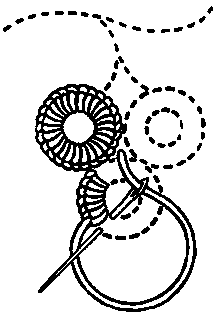
In everyday language, a stitch in the context of embroidery or hand-sewing is defined as the movement of the embroidery needle from the back of the fibre to the front side and back to the back side. The thread stroke on the front side produced by this is also called stitch. In the context of embroidery, an embroidery stitch means one or more stitches that are always executed in the same way, forming a figure. Embroidery stitches are also called stitches for short.
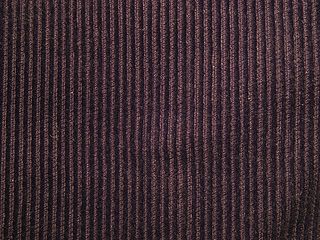
Corduroy is a textile with a distinct pattern, a "cord" or wale. Modern corduroy is most commonly composed of tufted cords, sometimes exhibiting a channel between the tufts. Both velvet and corduroy derive from fustian fabric.
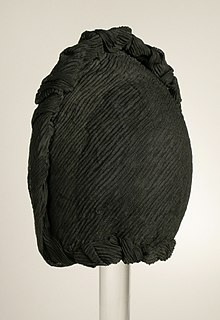
Crêpe, also spelt crepe or crape, is a silk, wool, or synthetic fiber fabric with a distinctively crisp, crimped appearance. The term crape typically refers to a form of the fabric associated specifically with mourning. Crêpe is also historically called crespe or crisp.
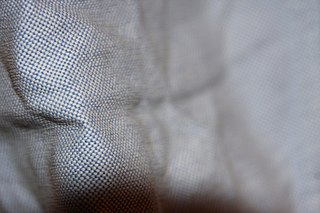
Oxford is a type of woven dress shirt fabric, employed to make a particular casual-to-formal cloth in dress shirts that may be called Oxford shirts.

Ballistic nylon is a thick, tough, nylon fabric with several uses. Ballistic nylon was developed by the DuPont corporation as a material for flak jackets to be worn by World War II airmen. The term ballistic nylon originates in the fabric's intended function, protecting its wearers from flying debris and fragmentation caused by bullet and artillery-shell impacts.
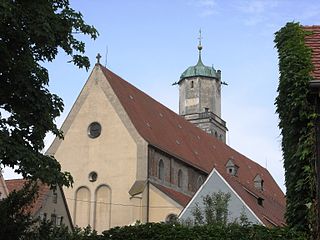
A canopy is an overhead roof or else a structure over which a fabric or metal covering is attached, able to provide shade or shelter from weather conditions such as sun, hail, snow and rain. A canopy can also be a tent, generally without a floor. The word comes from the Ancient Greek κωνώπειον, from κώνωψ, which is a bahuvrihi compound meaning "mosquito". The first 'o' changing into 'a' may be due to influence from the place name Canopus, Egypt thought of as a place of luxuries.
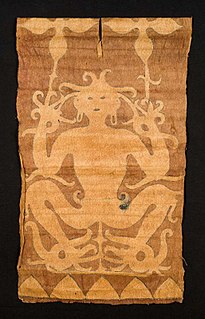
Barkcloth or bark cloth is a versatile material that was once common in Asia, Africa, and the Pacific. Barkcloth comes primarily from trees of the family Moraceae, including Broussonetia papyrifera, Artocarpus altilis, and Ficus natalensis. It is made by beating sodden strips of the fibrous inner bark of these trees into sheets, which are then finished into a variety of items. Many texts that mention "paper" clothing are actually referring to barkcloth.
The manufacture of textiles is one of the oldest of human technologies. To make textiles, the first requirement is a source of fibre from which a yarn can be made, primarily by spinning. The yarn is processed by knitting or weaving, which turns yarn into cloth. The machine used for weaving is the loom. For decoration, the process of colouring yarn or the finished material is dyeing. For more information of the various steps, see textile manufacturing.

Ultrasuede is the trade name for a synthetic ultra-microfiber fabric invented in 1970 by Dr. Miyoshi Okamoto, a scientist working for Toray Industries. In Japan it is sold under the brand name Ecsaine. It is often described as an artificial substitute for suede leather. The fabric is multifunctional: it is used in fashion, interior decorating, automobile and other vehicle upholstery, and industrial applications, such as protective fabric for electronic equipment. It is also a very popular fabric in the manufacture of footbags and juggling balls. Other manufacturers such as Sensuede and Majilite also produce similar product lines of synthetic microfiber suede.

Aircraft fabric covering is a term used for both the material used and the process of covering aircraft open structures. It is also used for reinforcing closed plywood structures, the de Havilland Mosquito being an example of this technique, and on the pioneering all-wood monocoque fuselages of certain World War I German aircraft like the LFG Roland C.II, in its wrapped Wickelrumpf plywood strip and fabric covering.
References
| This article about textiles is a stub. You can help Wikipedia by expanding it. |


